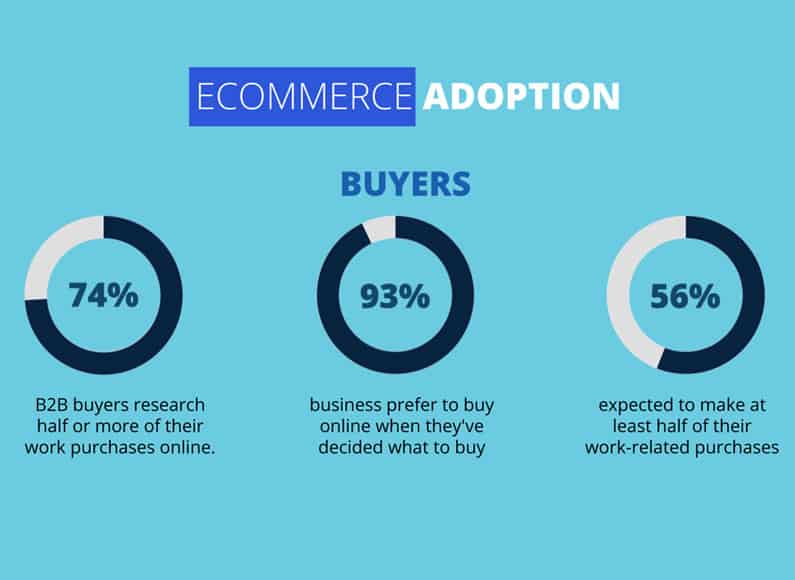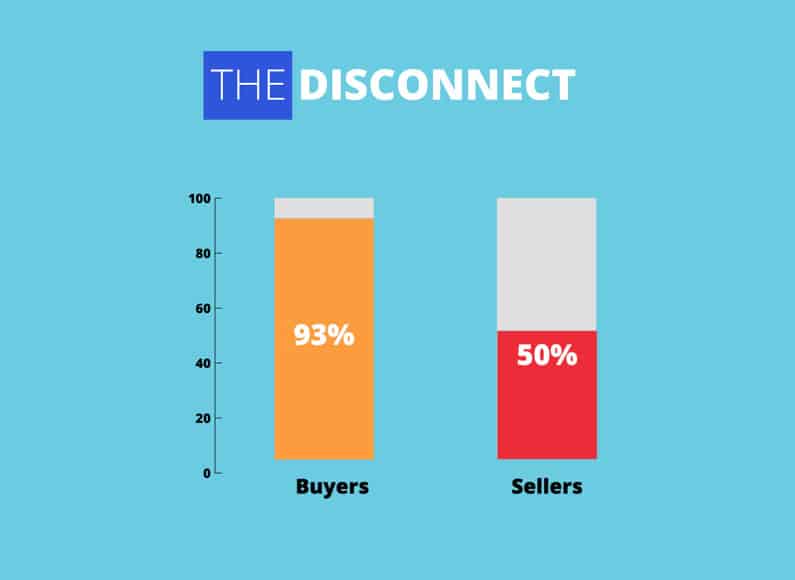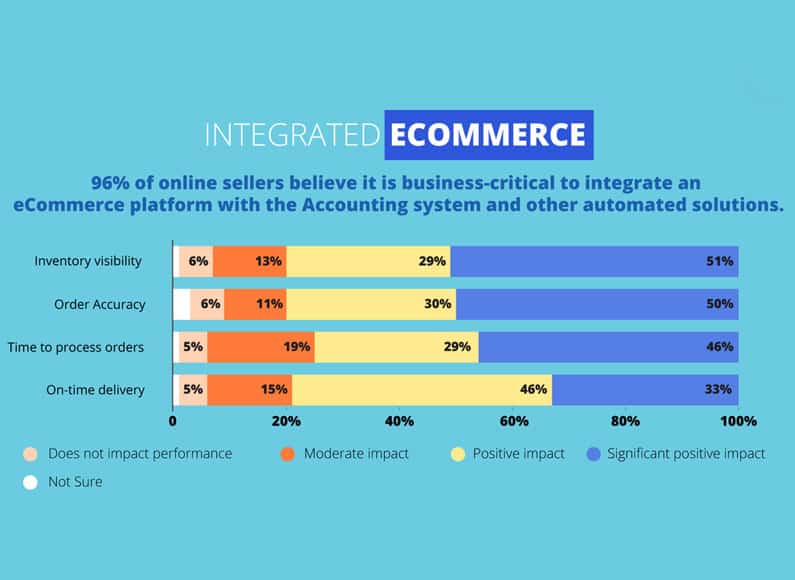Online shopping has become ubiquitous with retail customers with the rise of the Amazons and Alibabas of the world. You can buy almost anything you want online, or research purchases before ever contacting or visiting a retailer.
Where Are We Today?
In 2017 online retail sales reached $2.3 trillion USD according to Statista accounting for 10.2% of all retail sales worldwide. That’s forecasted to grow to almost $4.9 trillion by 2021.
Those are big numbers. But when compared to their B2B counterparts, they’re dwarfed. In 2017 worldwide B2B ecommerce accounted for $7.7 trillion USD or almost 2.5 times higher than B2C sales.

What Does the Future Hold?
By 2021 it is forecasted that in the US alone B2B ecommerce sales will eclipse $1 trillion with over 13% of all B2B purchases being done online. That represents an average annual growth rate between 2017 and 2021 of 7.3%.
B2B Buyer Behavior
It’s probably safe to assume that people want a similar buying experience at work as they get in their personal shopping life. And realistically, why not?
TradeGecko highlighted some key findings from Magneto IT Solutions’ B2B eCommerce Trends 2018 infographicB2B in their recent blog post.
With ¾ of B2B buyers doing their purchase research online and almost all of them preferring to buy online, it’s easy to see why the B2B numbers are so staggeringly large and growing.
In fact, a majority of exB2B buyers expect to make at least half of their business purchases online.

How do SMBs Stack Up in the Online Marketplace?
It’s surprising how often we hear a business owner or sales executive say something like “Our customers are very low tech. They would never order online. They don’t even know what Amazon is.”
Really!
Whether you believe it or not, your customers are shopping online and the statistics and research bear that out. If you don’t adapt, they will find a supplier who will. Unless your company is the only one of the planet that provides the products or services that you sell, you’re in for a rude awakening. To quote US Army General and former Chief of Staff Eric Ken Shineski, “If you dislike change, you’re going to dislike irrelevance even more.”
According to Brian Beck, Senior Vice President of E-Commerce and Omnichannel Strategy at Guidance, in a recent blog post, only half of manufacturers and brands currently have ecommerce websites.
When more than 90% of B2B buyers want to buy online and less than half of sellers are providing that option, we’ve got a disconnect. And that disconnect looks a lot like opportunity for those astute enough to recognize it.

What’s a Small Distributor to Do?
Ecommerce represents an opportunity for small to medium sized businesses (SMBs) to compete with much larger companies. It’s no longer the exclusive domain of the giants with massive marketing and technology budgets to have a compelling online presence. With a relatively moderate budget and a willingness to learn the tactics for search engine optimization, Google Ads, and keyword research, smaller companies can compete very well against their much larger rivals.
According to Justin King of B2X Partners in his blog post Small and mid-sized distributors, you CAN compete online, SMBs can build online sales if they follow the right steps. According to Justin, those steps are:
- Integration with your ERP
- Creative Design
- Product Data
Let’s explore each of those steps in more detail.
Integration with your ERP
This is arguably one of the more crucial steps because it can buy you leverage and agility over your bigger competitors. Research done by TradeGecko shows that 96% of online sellers believe integration is business-critical.
When your online store is properly integrated to your ERP it means that you don’t need to devote staff time to keep the inventory in sync, pricing current and accurate for different customers, orders entered into the ERP, payments processed, and a myriad of other tasks required to keep both systems up-to-date. All that will be handled automatically by the ecommerce platform.

Not all integrations are created equal, however. Do your research on this to be sure you’re getting what you need. For example, our firm, North49, has developed an ecommerce platform called Webtelligence that is purpose built to be integrated to Sage 300. Because we have a 30 year history of developing add-ons and customizations for Sage 300, we have an intimate knowledge of the data structure and business process flow. That allows us to create a very tightly integrated web store that will honor customer specific pricing, payment terms, data structures, business process flows, etc., eliminating the need to ever enter any piece of data more than once. It also means that product data and pricing is maintained in Sage and made available automatically to the web store.

Depending on your ERP you may not be able to find a purpose built ecommerce solution. In that case you will need the services of an integrator. That integration may not be as deep as what we provide but will likely deal with many of the day to day integration issues and eliminate some of the duplication of effort required to keep both systems in sync.
The reason ERP integration is key to keeping you ahead of your competition is agility and resource allocation. Bigger companies are often mired by outdated legacy systems that are very expensive to replace or maintain. And they have arduous procedures for keeping data current. You won’t have that problem with an integrated system.
Creative Design
Web site design deals with a few important aspects of the overall usability and appearance of the site. In most cases a business has spent years building its brand and image. You want to be sure that they are accurately portrayed on the site.
Many ecommerce platforms provide templates to choose from that will hopefully provide the image and experience you want for your customers. And usually some minor modifications are possible. That may be less than ideal for more discerning companies that want to control every aspect of their customers’ experience with their brand. If you’re more in the latter camp, you may want to work with a provider that offers design as part of the process. The designer will work closely with your team to create an experience that will optimize customer engagement and sales while respecting your brand image.
A B2B site is different from a B2C site. Generally it’s not about casual shoppers browsing the site. B2B buyers have a specific objective and typically want to get down to the business of ordering what they need as quickly as possible so they can get back to work.
To facilitate that you may want to include quick order features like a private catalog with their frequently purchased products, a quick order pad that allows them to enter a product name or number on a form, a reorder from prior orders option, or similar capabilities. But, you still want to expose them to your other products in the process so you need to employ creative tactics to do that. Things like related items to what they are ordering, or new this month banners, or similar tactics can be effective.
The objective of B2B site is to get the order as quickly and efficiently as possible while maximizing your order value.
Product Data
Dealing with current customers is one thing, which is largely what we spoke about in the previous section. But you don’t want to ignore potential new customers who are researching new suppliers. Good product descriptions can be the difference between landing a new customer or not.
There are lots of online blogs that provide detailed guides on how to write compelling product descriptions. For example, Bootstrappng Ecommerce wrote this blog, Product Descriptions: How to Write Persuasive Copy That Sells that also links to other blog posts with more tips.
To paraphrase the post, there are no salespeople on your site so your product descriptions are your salespeople. They must excite, engage and persuade customers to buy.
If it seems like a daunting task to create compelling descriptions for all of your products, start with your most popular products and build the rest over time. It’s also important to refresh those descriptions from time to time to keep them current and to stay relevant in the eyes of search engines.
Good product images are also important to enhance a product page and increase sales. And increasingly, video has become an effective way to provide compelling content that will convert shoppers to buyers.
If you provide products that are more technical in nature, providing access to technical specification documents, user guides, installation guides, schematics, material safety data sheets, or other relevant documents can provide a complete picture for buyers allowing them to confidently make a purchase from your site.
Conclusion
It’s clear that a vast majority of B2B buyers want to either research or make their purchases online. With only 50% of B2B sellers providing that capability, that leaves a wide open door for astute wholesaler distributors to capture a bigger share of the market by giving buyers what they want.
When designing your web store, make the buying process as easy as possible but provide access to detailed information when they want it. Navigation must be intuitive with the shortest path possible to place an order. It’s not rocket science but it does take some knowledge to do it well. That’s when you engage the services of the pros to help. Choose your ecommerce partner well and you will see results.
About North49
North49 is the publisher of Webtelligence, an ecommerce platform purpose built to be deeply integrated to Sage 300. Our people have decades of experience developing products for Sage 300 and ecommerce. We help our clients better serve their customers with integrated web stores, customer portals, and salesperson portals. Please contact us if we can be of service to you and your customers.
